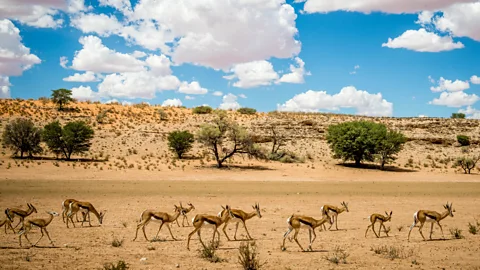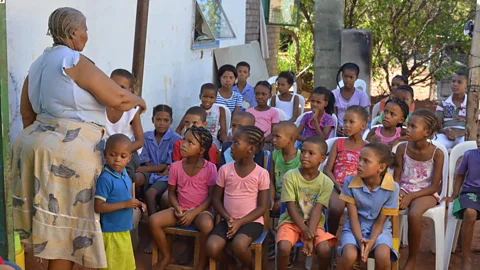South Africa's language spoken in 45 'clicks'
 Martin Harvey/Getty Images
Martin Harvey/Getty ImagesWith an incredible 45 clicks in its repertoire, the San language N|uu is one of our most startlingly beautiful examples of cultural diversity.
On the outskirts of Upington, in South Africa's Northern Cape, there lives a queen. The queen is elderly and when she dies it may not just be she who is gone, but an entire realm.
Katrina Esau is 88. Her community crowned her Queen of the Western Nǁnǂe (ǂKhomani) San in 2015. A year earlier, then-president Jacob Zuma presented her with the National Order of the Baobab in Silver.
For the previous eight decades, Esau had gone largely unnoticed. Her people, the San – of whom the Western Nǁnǂe (ǂKhomani) are one group of many – are good at that. Their survival depended on it: first for the countless centuries that they had South Africa to themselves, living deftly on the land as hunter gatherers. And then, with the arrival of other groups, to evade the scrutiny of those who meant them harm.
 SATourism/Alamy
SATourism/AlamyEsau was born on the farm where her parents worked. The farm's Afrikaner owner obnoxiously renamed the young queen "Geelmeid". "Meid" means "maidservant" while "geel" (yellow) is a crass reference to skin tone. Today, some still know her – lovingly – as Ouma (Grandma) Geelmeid. But often it's Queen Katrina.
The farm owner also forbade Esau from speaking her mother tongue, N|uu; a language with roots to humanity's very origins. Instead, the newly minted Afrikaans language (a mere 300 or so years old) would be Esau's camouflage for almost her entire life.
Cut off on the isolated farm, speaking Afrikaans, Esau began "burying" the language that she had "sucked from [her] mother's breast". This act of burial was just one funeral of many: the language, a descendant of those spoken by the first humans, had already been dealt its death blow a decade or so earlier.
The year 1931 saw the opening of the Kalahari Gemsbok National Park (now incorporated into the Kgalagadi Transfrontier Park). The terrain here is semi-desert, with two dry riverbeds, the Nossob and Auob, that flow once in a blue moon. Yet for the ǂKhomani, the last community of people to speak Esau's language, the landscape was home. The park's opening saw the ǂKhomani families evicted and scattered, smashing the one remaining circuit board of the language. ǂKhomani children would henceforth be born into a world of Afrikaans.
Along with !Xun (spoken in Namibia), ǂAmkoe and Taa (both spoken in Botswana), N|uu is one of our last linguistic links to the earliest humans: the hunter gatherers of southern and eastern Africa. All four languages are endangered: ǂAmkoe has 1,000 or so speakers; Taa 3,000 speakers; and !Xun 14,000 to 18,000.
N|uu, meanwhile, has just two: Esau and her brother Simon Sauls.
 Edwin Remsberg/Getty Images
Edwin Remsberg/Getty ImagesWe don't know when the N|uu language developed – it is too ancient to age precisely – but certainly its roots could not be deeper. Yet if it becomes one of the 600 to 800 languages likely to disappear in the near future, it's not just its antiquity that we should mourn. N|uu's richness and beauty are also astonishing: English has 44 distinct speech sounds (phonemes), for instance, while N|uu has 114.
Then there are its clicks. The bar in "N|uu" represents a click consonant – specifically a dental click, articulated with the tongue tip sucking quickly away from the upper teeth. A century ago, at least 100 indigenous click languages were likely spoken in the southern and eastern regions of Africa. To those unfamiliar with clicks, it can seem as if a click-language speaker's mouth has morphed into a percussion instrument. Consider that N|uu makes meaningful distinction between an incredible 45 clicks; to hear the language spoken fluently is to experience a linguistic fireworks display.
The star of the N|uu click repertoire is the phenomenally rare bilabial "kiss click", which sounds uncannily like an air smooch and features in just two of the world's 7,000 or so other languages. (One of them is Taa, which has 111 click phonemes.)
As Esau's years have advanced, her urgency to sow new seeds of N|uu has increased. In the early 2000s, she started teaching the language to her community from a schoolroom built in her front yard in Rosedale, a township near Upington, using song, dance and play. Her pupils, who range in age from three to 19, are the only students of N|uu in the world.
 Matthias Brenzinger
Matthias BrenzingerIn recent years, others have bolstered Esau's efforts. A team of linguists has helped create an orthography and educational materials for N|uu, meaning that her granddaughter Claudia Snyman can teach the written language (Esau can't read). Tortoise and Ostrich, a children's storybook in N|uu, Afrikaans and English was published in May.
But the beauty of N|uu should not be used to paint an unduly romantic picture of Esau's people – the San. Michael Daiber is manager of the !Khwa ttu heritage centre, an hour's drive north of Cape Town, which calls itself the "embassy" of the San. He says the centre, which also offers accommodation, is an antidote to the "sunsets and silhouettes and smiling people" image of the San.
"Establishments used to promote that naked hunter-gatherer Bushman image," Daiber explained. "All that 'the last surviving', 'unique encounter', 'come and see it while it's still here' language. The leaders who founded !Khwa ttu back in 1996 were saying, 'This is not our story. Our land has been taken away from us. We have had a really tough history.'"
"Where San live, it looks like unoccupied land," added Joram /Uiseb, a San of the Namibian Hai||om group, who is heritage co-ordinator at !Khwa ttu. "Land is life. Only take from nature what you really need." For the San, land was about stewardship not ownership, and South Africa was easily wrested from them.
"In the 1980s, I was told there were no Bushmen left," Daiber said . "And here 40 years later I've had a career working only with San people. How do you measure it and who decides">window._taboola = window._taboola || []; _taboola.push({ mode: 'alternating-thumbnails-a', container: 'taboola-below-article', placement: 'Below Article', target_type: 'mix' });
